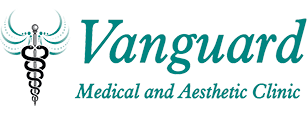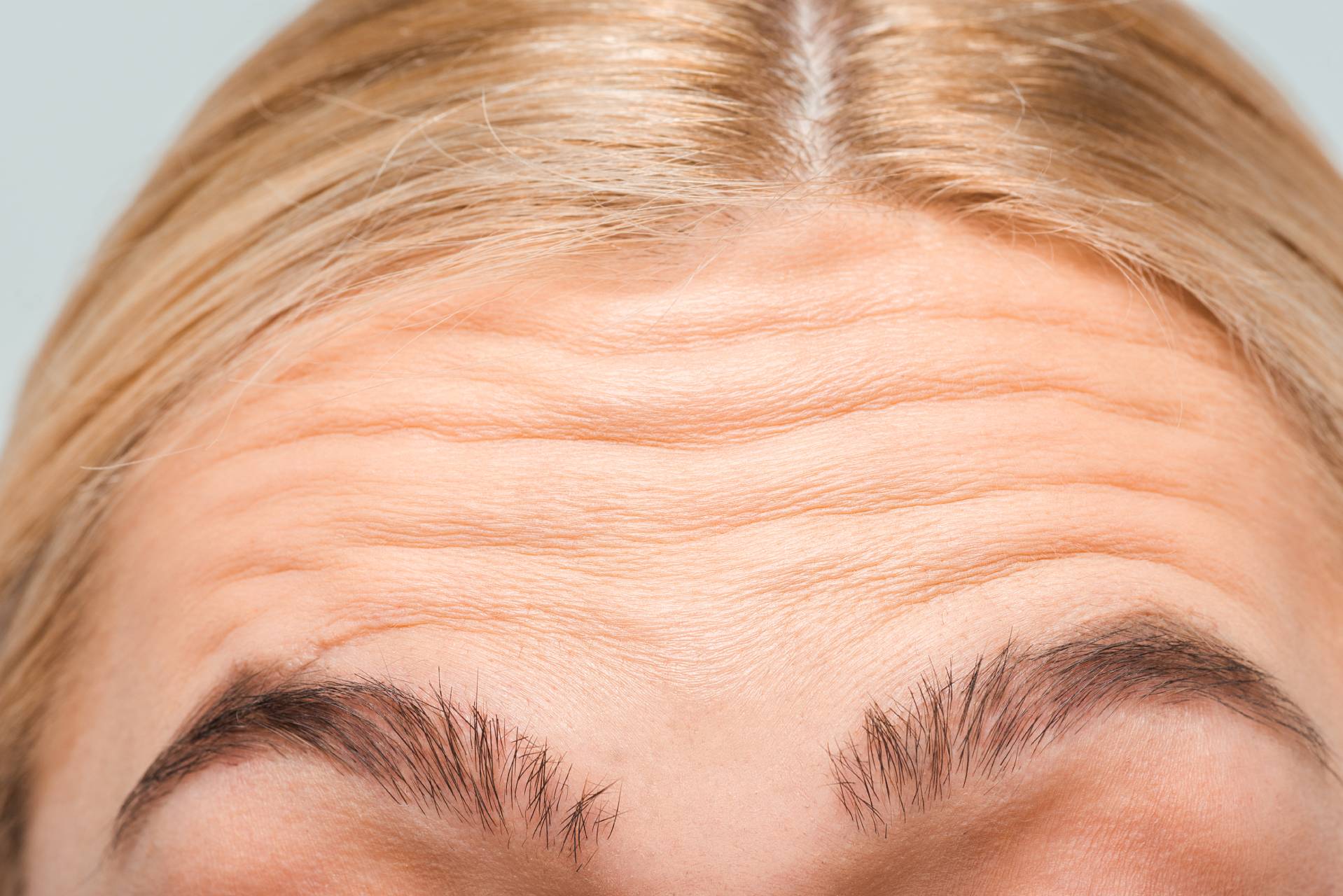Forehead wrinkles are lines or creases that develop on the forehead due to various factors, including aging, repetitive facial expressions, sun exposure, and genetic disposition. These wrinkles typically appear as horizontal lines across the forehead, although vertical lines can also form between the eyebrows. This guide will cover the causes of forehead wrinkles and several options for treating them.
What Causes Forehead Wrinkles?
There are several factors that can cause forehead wrinkles. Here are the top causes:
Aging
As people age, the skin naturally loses its elasticity and firmness due to a decrease in collagen and elastin production. This loss of structural support leads to the formation of wrinkles, including those on the forehead.
Repetitive Facial Expressions
Frequent and repetitive movements of the facial muscles, such as raising the eyebrows or furrowing the brow, can contribute to the development of wrinkles over time. These dynamic wrinkles become more prominent with age as the skin loses its ability to bounce back.
Sun Exposure
Ultraviolet (UV) radiation from the sun can damage the skin’s collagen and elastin fibers, leading to premature aging and the formation of wrinkles. Prolonged exposure to the sun without adequate protection, such as sunscreen and protective clothing, can accelerate the development of forehead wrinkles.
Genetics
Some people may be genetically predisposed to developing wrinkles at an earlier age or more prominently than others. Genes can influence factors such as skin thickness, elasticity, and how quickly collagen breaks down, all of which contribute to wrinkle formation.
While these are the top causes of forehead wrinkles, other factors such as smoking, poor skincare habits, environmental pollutants, and dietary factors can also contribute to wrinkle formation. It is essential to adopt healthy lifestyle habits, protect the skin from sun damage, and follow a skincare routine to help minimize the appearance of wrinkles and maintain youthful-looking skin.
What are Treatment Options for Forehead Wrinkles?
Treating forehead wrinkles can improve overall skin appearance, boost self-confidence, and enhance a youthful appearance. Addressing forehead wrinkles early may prevent them from becoming more pronounced over time and can contribute to a more refreshed and rejuvenated look. Additionally, addressing forehead wrinkles may also help improve skin health and prevent further signs of aging. Here are a few treatment options for forehead wrinkles:
Botox
Botox is commonly used to reduce the appearance of wrinkles and fine lines by temporarily paralyzing or weakening the muscles responsible for creating these wrinkles. When injected into specific facial muscles, Botox blocks the signals from the nerves to the muscles, preventing them from contracting. This temporary relaxation of muscles smoothes out wrinkles and fine lines in the overlying skin. Botox is particularly effective for treating dynamic wrinkles, which are caused by repetitive facial movements, such as frowning, squinting, or raising the eyebrows.
For treating forehead wrinkles, Botox is injected into the muscles responsible for raising the eyebrows and creating horizontal lines on the forehead. By selectively targeting these muscles, Botox relaxes them, reducing the appearance of forehead wrinkles. This treatment involves multiple small injections into specific areas of the forehead. Results usually become noticeable within a few days to a week after the injections and can last for several months, depending on individual factors such as metabolism and muscle activity.
It is essential to have Botox injections performed by a qualified professional to ensure safety and optimal features. Consulting with a qualified professional is important before undergoing Botox treatment for forehead wrinkles.
Dermal Fillers
Dermal fillers are injectable substances that are used to add volume, smooth out wrinkles, and rejuvenate the appearance of the skin. When used to treat forehead wrinkles, dermal fillers work by filling in and plumping up the creases and lines on the skin’s surface. Dermal fillers physically add volume to the skin, thereby smoothing out wrinkles and providing a more youthful appearance.
The procedure typically involves injecting the dermal filler directly into targeted areas of the forehead. The specific injection technique and the amount of filler used will depend on factors such as the depth and severity of the wrinkles, the desired outcome, and the type of filler being used. Dermal filler treatments for forehead wrinkles are typically quick and relatively painless, with minimal downtime. Results are immediate and can last anywhere from several months to over a year, depending on the type of filler used and individual factors such as metabolism and lifestyle.
As with any cosmetic procedure, it is essential to have dermal filler injections performed by a qualified professional to ensure safety and optimal results. It is crucial to consult with a qualified professional before undergoing dermal filler treatment for forehead wrinkles.
Microneedling
Microneedling, also known as collagen induction therapy, is a cosmetic procedure that involves using a device with fine needles to create tiny punctures or micro-injuries in the skin. These micro-injuries simulate the skin’s natural healing response, leading to increased collagen and elastin production. This helps to plump up the skin, smooth out wrinkles, and improve overall skin texture.
Depending on the specific concerns and desired outcomes, microneedling can be performed at various depths and with different types of devices. In addition to treating forehead wrinkles, microneedling can also help improve the appearance of other skin concerns, such as acne scars, uneven skin tone, and texture irregularities. The procedure is typically suitable for all skin types and can be performed on various areas of the body, including the face and neck.
Results from microneedling are gradual and may become more noticeable over time as collagen production continues. Multiple sessions are often recommended to achieve optimal results, with most patients seeing improvements in skin texture and appearance after a series of treatments. However, microneedling may not be suitable for individuals with certain skin conditions or medical concerns. It is essential for individuals to consult with a qualified professional to determine if microneedling is the right treatment option for them.
Microdermabrasion
Microdermabrasion is a non-invasive cosmetic procedure that exfoliates and rejuvenates the skin by removing the outermost layer of dead skin cells. It uses a device to gently abrade the skin’s surface, followed by suction to remove the exfoliated skin cells and debris. When used to treat forehead wrinkles, microdermabrasion works by stimulating cell turnover and collagen production in the skin. By removing the outer layer of dead skin cells, microdermabrasion helps to smooth out fine lines and wrinkles, improve skin texture, and promote a more youthful appearance.
Microdermabrasion is a generally painless treatment that requires little to no downtime, making it a popular choice for individuals seeking quick and effective skin rejuvenation. It can be performed as a standalone treatment or in combination with other cosmetic procedures. For optimal results, multiple sessions of microdermabrasion may be recommended, spaced several weeks apart.
While microdermabrasion can help improve the appearance of forehead wrinkles and other signs of aging, it may not be suitable for everyone. It is essential to consult with a qualified professional to determine if microdermabrasion is the right treatment option for addressing forehead wrinkles and achieving one’s desired skincare goals.
When it comes to treating forehead wrinkles, it is crucial to consult with a qualified professional who can assess your individual skin condition, determine the most suitable treatment options, and tailor a personalized plan to help you achieve optimal results while minimizing risks. Qualified professionals have the expertise and training to perform treatments safely and effectively, ensuring that you receive appropriate care and guidance throughout the process. Additionally, a qualified professional can provide you with valuable advice on skincare routines, lifestyle modifications, and maintenance strategies to help you achieve long-lasting improvements in the appearance of your skin.

